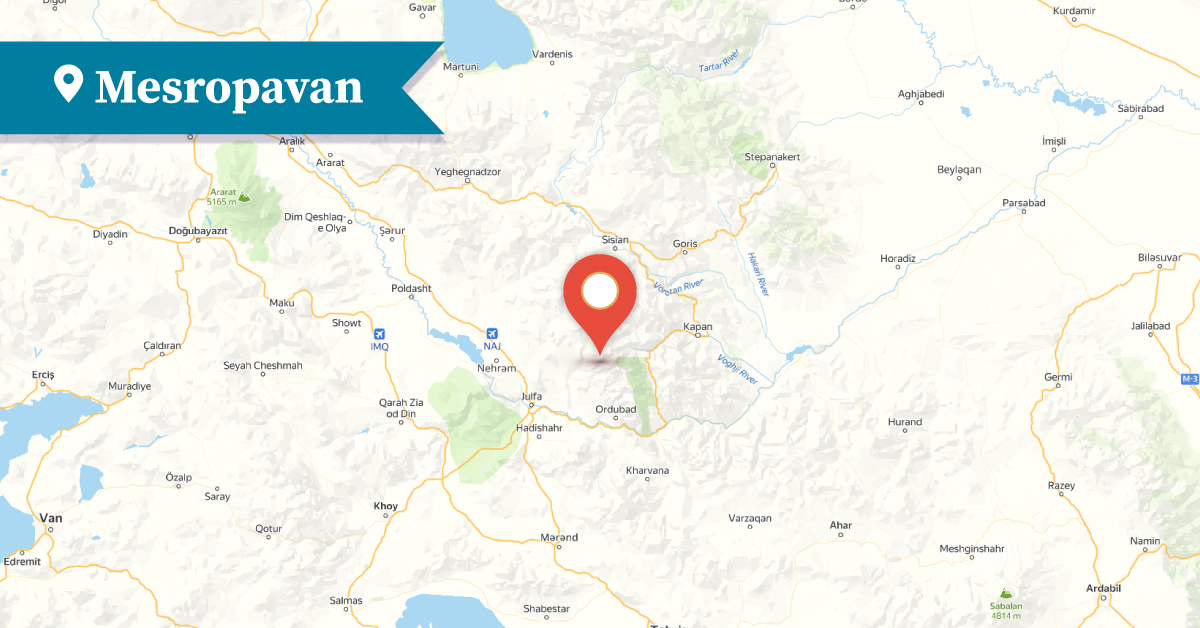2025
2025
2025-04-11

The village of Nasrvaz in the Ordubad district of the Nakhichevan Autonomous Republic is the historically Armenian Mesropavan[1]. The settlement is located at the foot of the mountains, rich in vegetation and ancient orchards. The Armenian name of the village—associated with Mesrop Mashtots—has undergone phonetic distortions and changes over time. According to tradition, Mesrop Mashtots lived with his disciples for 17 years in one of the natural caves at the foot of Mount Krnakoch, which surrounds the village, until the construction of the Saint Gregory the Illuminator Monastery.
This story is at the root of the toponym. In Mesropavan—an inseparable part of Armenian history—tombstones and khachkars (cross-stones) dating back to the 9th–15th centuries have also been found. The Azerbaijanis have not only changed and distorted the name of the village, but they have also translated and continued to use the name of one of the surrounding mountains—originally known as Tapanasar or Navasar—as "Mountain of the Ship" (Gəmiqaya dağı).
The renowned Saint Gregory the Illuminator Monastery in the village is also known as the Mesrop Mashtots Monastery. According to tradition, it was built in 456 AD by Prince Shabit of Goghtn. According to an old tax register dating to the 13th century, Saint Gregory the Illuminator Monastery paid taxes to the Tatev Monastery.
Argam Ayvazyan, a prominent Armenologist and cultural historian, in his study “The Historical and Architectural Monuments of Nakhijevan”, noted that the Saint Gregory the Illuminator Church of Mesropavan was renovated in the 15th and 17th centuries, and for the last time at the end of the 19th century. He wrote: “At present, the church is the only remaining monument of the monastic complex, and it is in a semi-ruined condition.”
The Azerbaijanis completely destroyed the monastery between 1997 and 2005, leaving no trace.
Mesropavan was also one of the regions where an ancient language known as Zok was spoken. There is also a legend that the language was incomprehensible to other Armenians of the surrounding areas. One widespread view is that the Zoks were half-Armenian, half-Jewish merchants who created a secret language to prevent outsiders from understanding their commercial codes. Linguist Bert Vaux, in his research, concluded that Zok language was actually a dialect of the indigenous Armenian population of Nakhijevan, which had close interactions with the dialects of Karabakh and Jugha.
By destroying all the ancient Armenian monuments of Mesropavan, the Azerbaijanis have stripped the area not only of its Armenian identity but also of its historical past.
See
Ayvazyan, Argam. The Historical and Architectural Monuments of Nakhijevan. Yerevan: “Hayastan” Publishing House, 1978.
Ayvazyan, Argam. The Monuments and Sculptural Reliefs of Nakhijevan. Yerevan: "Hayastan" Publishing House, 1987.
Hakobyan, T. Kh., Melik-Bakhshyan, St. T., Barseghyan, H. Kh. Dictionary of Toponyms of Armenia and Adjacent Regions, Vol. 3. Yerevan: YSU Publishing House, 1991.
Bert Vaux, “Zok: The Armenian dialect of Agulis,” Between Paris and Fresno: Armenian Studies in Honor of Dickran Kouymjian, Costa Mesa, Calif, pp. 1-19
[1] The village has also naes Masrevan, Masrevank, Mesravan, Mesrobavan, Msrvan, Nazrvaz, Nasyrvaz, Nasırabad, Nasirapad, and Nasirvaz.